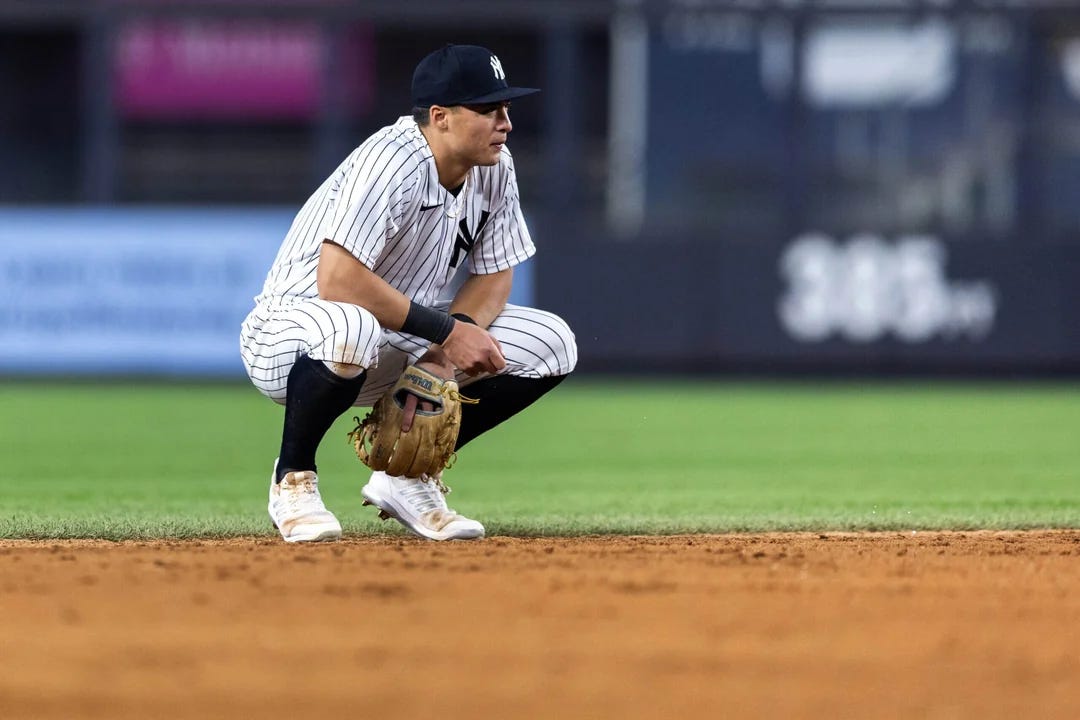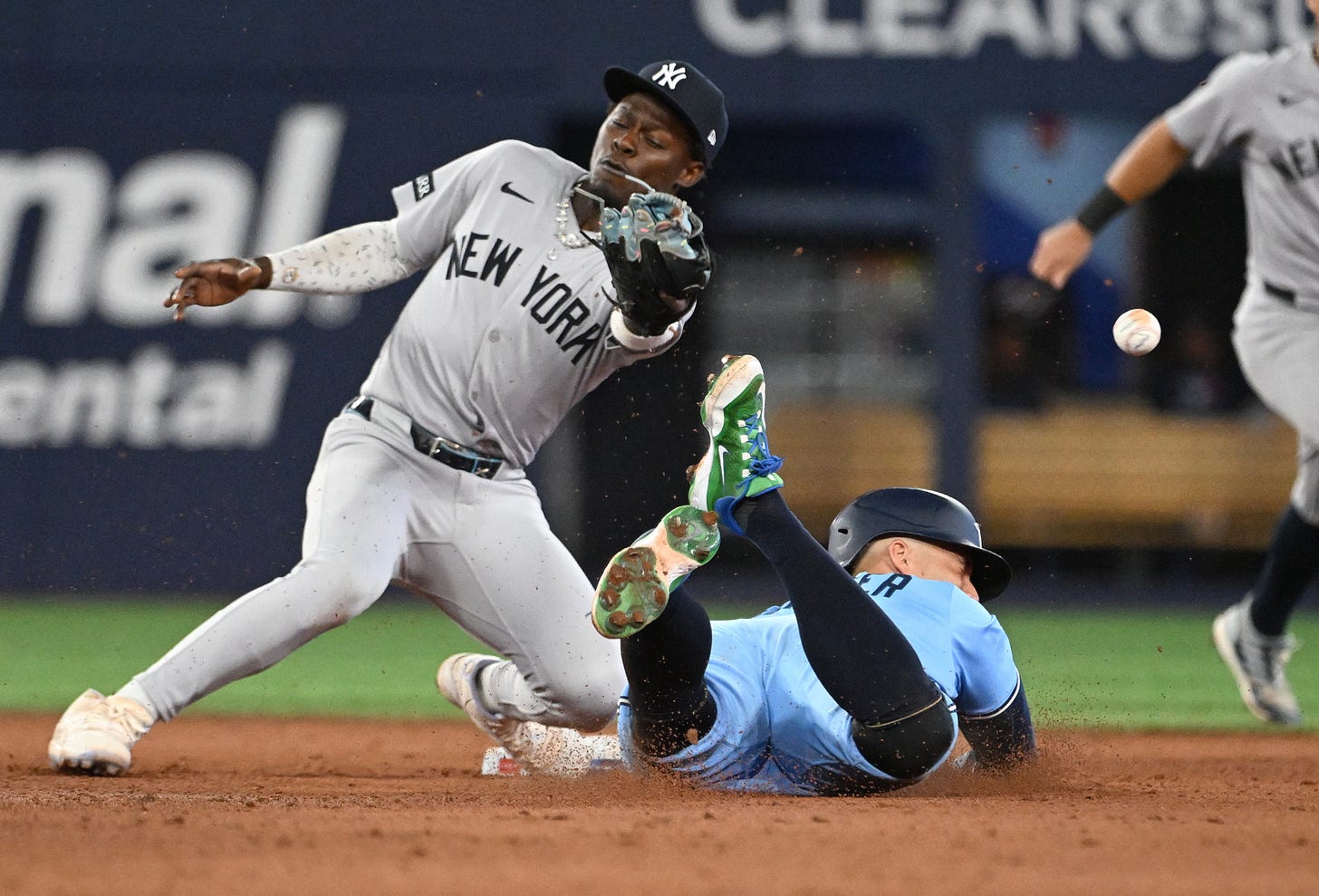The New York Yankees entered 2025 with championship aspirations, but their defensive play has become a glaring weakness that threatens to derail their postseason hopes. With 52 errors through 102 games and a team fielding percentage of .986, the Yankees are struggling to match their offensive firepower with reliable defense.
The Numbers Don't Lie: Yankees Defense By The Statistics
Looking at the team's defensive metrics reveals a troubling pattern. The Yankees have committed 52 errors in 102 games, translating to roughly one error every two games. While their .986 team fielding percentage appears respectable on paper, the underlying numbers tell a different story.
The most concerning issues emerge when examining individual player performance. Anthony Volpe, despite his promising rookie campaign, leads the team with 13 errors at shortstop while posting a below-average .962 fielding percentage. His defensive struggles have been particularly costly in crucial moments throughout the season.
Jazz Chisholm Jr., acquired to bolster the infield, has committed 11 errors across multiple positions, highlighting the team's difficulty in finding defensive stability.
Key Problem Areas Plaguing Yankees Defense
Infield Inconsistency
The Yankees' infield has been their primary defensive concern. The lack of defensive chemistry between middle infielders has resulted in missed double-play opportunities and routine grounders turning into base hits.
Volpe's adjustment to the major league level has been evident in his defensive metrics. His Rdrs (Defensive Runs Saved) of +2 suggests modest improvement potential, but his 13 errors indicate fundamental issues with consistency that typically plague young players making the transition.
Positional Versatility vs. Mastery
Manager Aaron Boone's approach of utilizing players across multiple positions has created versatility but sacrificed defensive mastery. Players like Oswaldo Cabrera and Pablo Reyes have been deployed at various positions, but their fielding percentages (.935 and .920 respectively) reflect the challenges of constant positional changes.
Jazz Chisholm Jr.'s defensive metrics show the impact of positional flexibility. While his range factor suggests adequate coverage, his error total indicates the adjustment period required when players frequently shift between second base, third base, and outfield positions.
Comparing to League Standards
When compared to league-average defensive metrics, the Yankees fall short in several key areas. Their team range factor per game (2.60) trails the league average (3.30), indicating that Yankees fielders are reaching fewer balls in play than their counterparts across baseball.
This defensive deficiency becomes more pronounced when considering the team's pitching staff relies heavily on contact pitchers like Carlos Rodón and Max Fried. Ground ball pitchers require reliable infield defense to maximize their effectiveness, making the Yankees' fielding struggles particularly problematic.
The Ripple Effect on Pitching Performance
Poor defense creates a compounding effect that extends beyond error totals. Pitchers lose confidence when routine plays become adventures, leading to elevated pitch counts and altered approach strategies. The Yankees' pitching staff has shown signs of this pressure, particularly in high-leverage situations where defensive miscues have extended innings unnecessarily.
Recent analytics suggest that the Yankees' defensive struggles have cost them approximately 8-10 additional runs compared to league-average defense, directly impacting their run differential and overall team performance.
Youth Development vs. Immediate Results
The Yankees face a classic baseball dilemma: developing young talent while competing for championships. Volpe's defensive growing pains represent the cost of prioritizing long-term development over short-term defensive stability. While his offensive contributions provide value, his defensive inconsistency creates daily lineup challenges.
The organization's commitment to player development means accepting these defensive shortcomings as part of the maturation process. However, in a competitive AL East division, every defensive miscue carries playoff implications.
Potential Solutions and Mid-Season Adjustments
Several strategies could address the Yankees' defensive woes. Reducing positional versatility requirements would allow players to focus on mastering specific positions rather than maintaining competency across multiple spots. Additionally, increasing practice time dedicated to fundamental defensive drills could improve consistency and reduce mental errors.
The team might also consider strategic roster moves, potentially targeting defensive specialists who could provide stability at key positions. Trade deadline analysis suggests several available players who could immediately upgrade the Yankees' defensive profile.
Looking Forward: Can Defense Derail Championship Dreams?
History shows that championship teams typically feature solid, if not spectacular, defense. The Yankees' current defensive struggles create unnecessary pressure on their offense to consistently produce high-scoring games. While their lineup possesses the talent to overcome defensive shortcomings in many games, playoff baseball demands defensive reliability when offensive production inevitably fluctuates.
The remaining months of the season will test whether the Yankees can address their defensive issues through internal improvement or external roster additions. Their championship aspirations may ultimately depend on finding defensive consistency to complement their offensive firepower.
The Yankees defense represents a fascinating case study in modern baseball construction – balancing youth development, positional flexibility, and immediate competitive needs. As the season progresses, their ability to solve these defensive puzzles will largely determine whether 2025 becomes a successful campaign or a missed opportunity.
For more in-depth Yankees coverage and MLB analysis, visit Up in The Rafters - your premier destination for professional sports journalism and statistical analysis.




